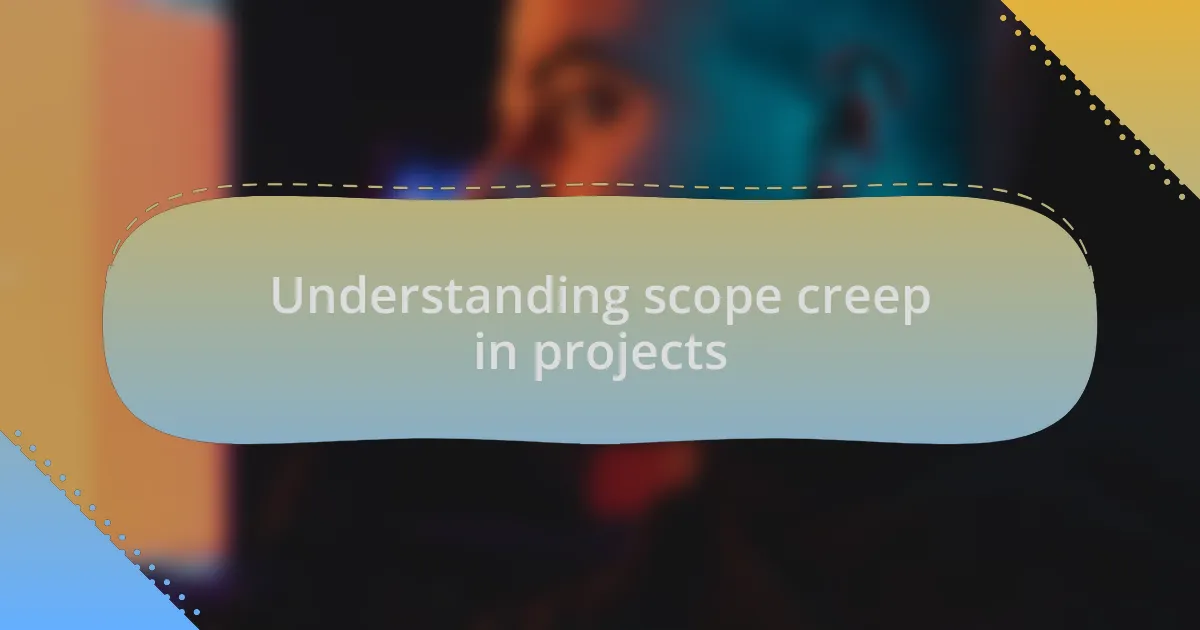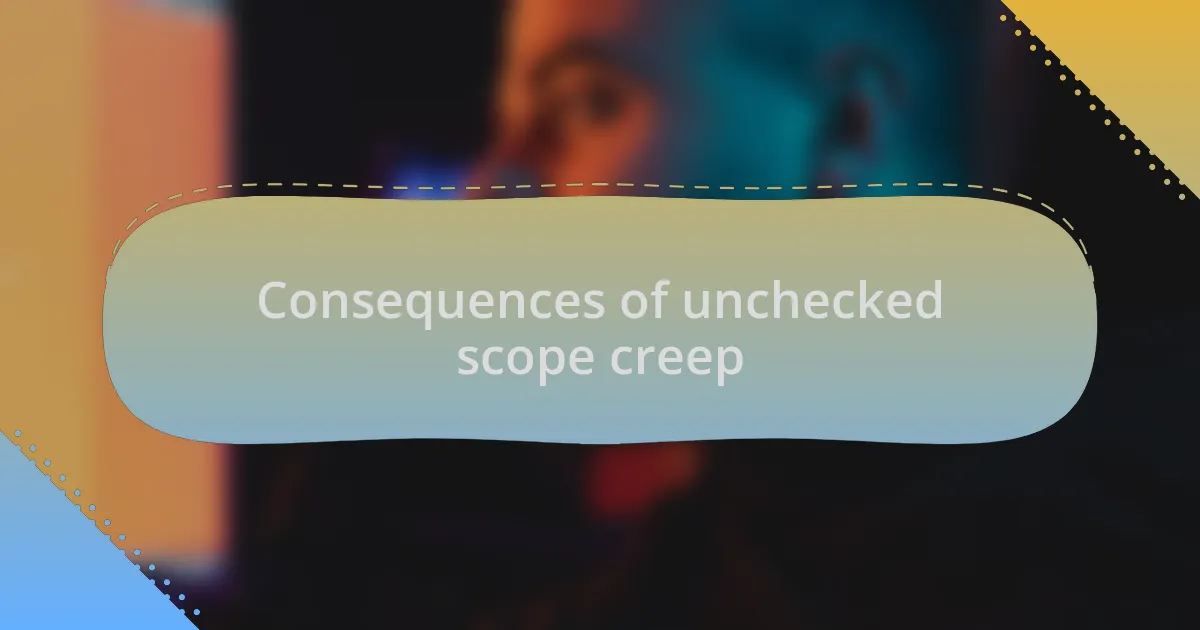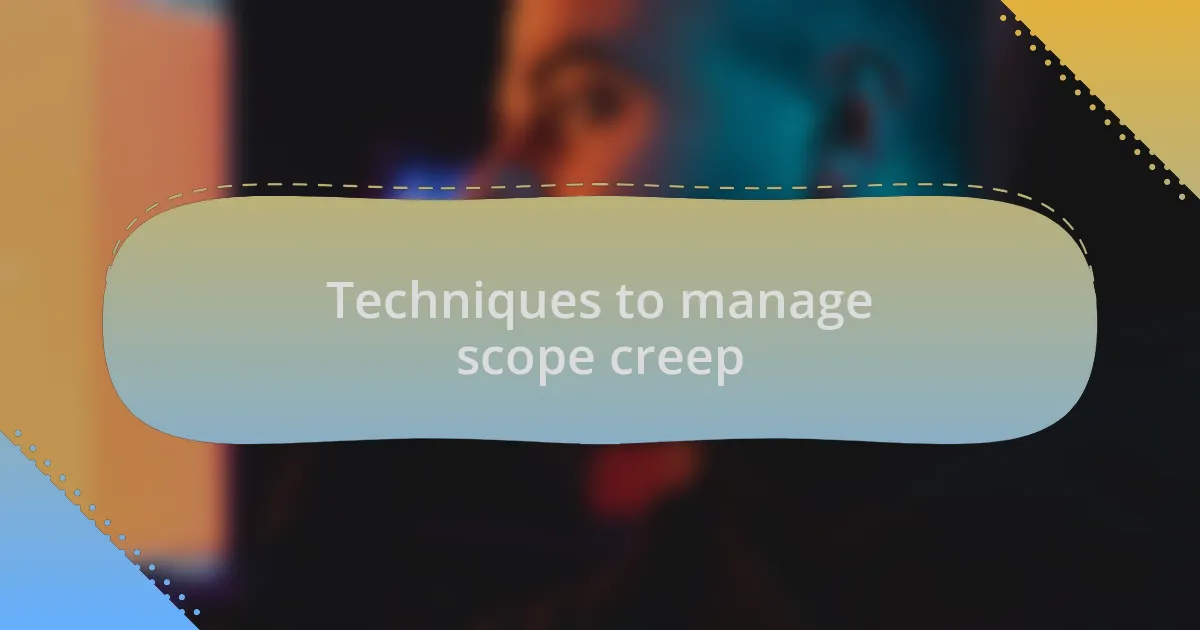Key takeaways:
- Scope creep occurs when unauthorized features or tasks are added, causing project delays and budget strains.
- Establishing clear project boundaries and involving stakeholders during the planning phase is essential to prevent scope creep.
- Implementing a prioritized backlog and regular check-ins can help manage new requests efficiently and keep the project on track.
- Educating stakeholders about the impact of changes fosters a collaborative atmosphere and encourages mindful decision-making regarding requests.

Understanding scope creep in projects
Scope creep is a common challenge that many project managers face, often arising when new features or tasks sneak into the project without proper approval. I remember a project where my team decided to add “just one more feature,” which ended up derailing our timeline and budget. Have you ever found yourself in a similar situation, wondering how something so small could cause such a big ripple effect?
Understanding scope creep involves recognizing its signs early. Often, it starts with seemingly harmless requests during meetings or casual conversations that can grow into substantial additions. For instance, while working on a software update, a client mentioned a “nice-to-have” feature that spiraled into a full-blown specification change. I realized then that clear communication about project boundaries is crucial.
To effectively combat scope creep, it’s vital to differentiate between essential project requirements and additional requests that can jeopardize timelines. Often, I ask myself, “Is this addition truly necessary, or can it wait for another phase?” This introspection not only helps in maintaining focus but also fosters healthier client relationships by managing expectations.

Consequences of unchecked scope creep
Unchecked scope creep can lead to significant project delays. I once worked on a mobile app where additional features kept surfacing. Each new request pushed our deadline further away, resulting in an anxious atmosphere within the team. Have you ever felt the pressure of looming deadlines while trying to meet endless client demands?
Another consequence is the strain it puts on resources, including budget and manpower. During a particularly ambitious project, our initial budget was quickly depleted as we scrambled to accommodate every new idea. It felt like we were stuck in a cycle of chasing after every change rather than delivering a quality product. Isn’t it frustrating when you realize that all your efforts are veering off course?
Ultimately, the quality of the final product can suffer. I vividly recall a project where, in an attempt to satisfy every request, the core features were compromised. Users reported a clunky experience, and the feedback was disheartening. That experience taught me the importance of setting clear priorities and sticking to them—how often do we sacrifice quality for the sake of meeting every demand?

Strategies to prevent scope creep
When managing a project, establishing a clear scope from the outset is essential. I find that involving all stakeholders in the initial planning phase helps set realistic expectations. It’s incredible how often I’ve seen projects take a sharp turn simply because one team member wasn’t on the same page. Have you experienced that frustrating moment when one minor change can derail the entire project?
Regularly reviewing and revisiting the project scope throughout its lifecycle can also significantly mitigate scope creep. I’ve seen project leaders who schedule periodic check-ins to discuss progress and any emerging requests. This approach not only keeps everyone aligned but also reinforces the original vision. It’s such a relief when everyone feels included and informed—don’t you agree it fosters a sense of teamwork?
Another strategy I’ve employed involves establishing strict change management procedures. When I encourage my team to document and assess every new request, it becomes a lot easier to prioritize or decline changes that could jeopardize our timeline. I remember a project where we utilized a simple form to evaluate each suggestion; it laid a clear pathway for discussion, making it apparent what we could realistically take on. How often do we allow ourselves to be swept up in enthusiasm without proper evaluation?

Techniques to manage scope creep
One effective technique I’ve found is the use of a prioritized backlog to manage new requests. When team members submit ideas or changes, I have them write them down and rank them based on impact and effort. This approach helps in making objective decisions about what to integrate into the project. I recall a time when this system saved us from overloading ourselves with features that sounded great but weren’t critical, allowing us to maintain focus and momentum. Have you ever felt overwhelmed by a flood of suggestions? Prioritizing makes it manageable.
Another strategy I use involves setting a “change freeze” period, especially approaching significant milestones or deadlines. During these phases, I communicate clearly that no new changes will be accepted unless they’re urgent and essential. I remember a project where this simple rule shielded us from last-minute alterations that could have jeopardized our delivery date. Can you imagine how frustrating it would be to reach the finish line only to have the finish line moved?
Lastly, I find that educating stakeholders about the impact of scope changes enhances their understanding and support. I often host brief sessions to discuss how even minor tweaks can derail budgets and timelines. When stakeholders realize their requests are connected to broader project implications, they tend to think twice before making changes. I genuinely believe that fostering this awareness creates a more collaborative atmosphere where everyone feels responsible for the project’s success. Have you noticed how informed stakeholders can change the dynamics of a project?

Personal experiences with scope creep
I once worked on a web development project where a minor feature request quickly spiraled into a major overhaul. We thought it would just be a quick add-on, but soon enough, every team member was suggesting changes tied to that one feature. It left me feeling frustrated, as I had to remind everyone about our original goals. Have you ever felt like you’re chasing your tail, trying to keep up with shifting demands?
In another instance, I experienced the importance of aligning expectations early on. At the project’s start, I made a strong effort to clarify what was on the table and what wasn’t, yet a couple of months in, the client brought up new ideas that seemed harmless but slowly began to shift our focus. I remember being torn between wanting to please the client and knowing the potential fallout of those additions. It’s interesting how easily we can lose sight of the core objectives, isn’t it?
Reflection on these episodes taught me the value of having clear boundaries and communication. I started to implement regular check-in meetings specifically to discuss scope concerns, allowing everyone to voice changes without derailing our progress. Recognizing the emotional toll that scope creep can have on team morale made me prioritize this practice. Has setting these boundaries helped you manage similar challenges in your projects?